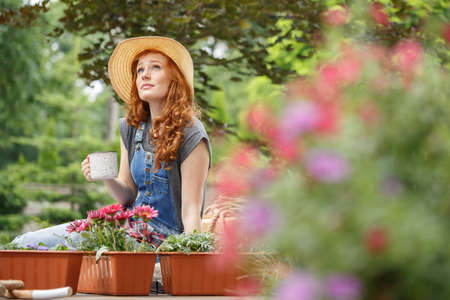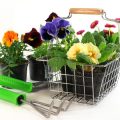1. Choosing the Right Plants for Climate and Style
Spring is the perfect time to refresh your garden with plants that not only look beautiful but also thrive in your local climate. Before heading to the nursery, it’s important to consider your USDA hardiness zone. This helps you choose plants that will grow successfully in your region without needing too much extra care.
Understanding Your USDA Hardiness Zone
The United States Department of Agriculture (USDA) has divided the country into zones based on average minimum winter temperatures. Knowing your zone will help you pick plants that are more likely to survive and flourish year after year. You can check your zone by visiting the official USDA website or asking at a local garden center.
Mixing Perennials, Annuals, and Edibles
A well-designed spring garden includes a variety of plant types. Combining perennials, annuals, and edible plants adds both visual interest and practical benefits like fresh herbs or vegetables. Here’s a simple guide:
| Plant Type | Description | Benefits | Examples |
|---|---|---|---|
| Perennials | Return every year after planting | Low maintenance, long-term beauty | Lavender, Coneflower, Daylilies |
| Annuals | Complete life cycle in one season | Add seasonal color and variety | Pansies, Marigolds, Petunias |
| Edibles | Herbs, fruits, or vegetables you can harvest | Functional and attractive | Basil, Cherry Tomatoes, Kale |
Selecting Plants That Complement Each Other
To create harmony in your garden design, think about plant height, color combinations, and bloom times. Layer taller plants in the back and shorter ones in front for depth. Choose colors that blend well or contrast in an appealing way—like purple lavender next to bright yellow marigolds.
Tips for Plant Pairing:
- Color Coordination: Use complementary or analogous colors for a cohesive look.
- Texture Variety: Mix fine and bold foliage textures for visual interest.
- Scented Choices: Add fragrant plants like rosemary or jasmine near walkways or seating areas.
Bonus Tip:
If youre short on space or live in an urban area, container gardening lets you mix edibles and flowers easily on patios or balconies. Try pairing cherry tomatoes with nasturtiums for a colorful and tasty combo!
With thoughtful planning based on your local climate and personal style preferences, you can create a spring garden that’s both stunning and productive.
2. Designing with Raised Beds and Vertical Elements
Raised beds and vertical gardening structures are game-changers when it comes to creating a spring garden that’s both beautiful and productive. Whether youre working with a spacious backyard or a compact urban lot, these tools can help you make the most of your space while adding visual interest.
Benefits of Raised Beds
Raised beds are elevated garden plots that offer better control over soil quality, drainage, and pests. They also make gardening more accessible—perfect for those who prefer not to kneel or bend down as much.
| Advantage | Description |
|---|---|
| Improved Soil Control | You can customize the soil mix to suit your plants’ needs. |
| Better Drainage | Excess water drains more easily, preventing root rot. |
| Pest Management | Easier to protect plants from ground-dwelling pests. |
| Accessibility | Easier on your back and knees—great for gardeners of all ages. |
Incorporating Vertical Gardening Structures
Trellises, arbors, and other vertical elements don’t just save space—they also bring height and structure to your garden design. These features are perfect for vining crops like tomatoes, cucumbers, peas, and even flowering plants like clematis or morning glories.
Popular Vertical Structures
- Trellises: Great for training climbing vegetables and flowers along fences or walls.
- Arbors: Create a stunning entrance or focal point while supporting flowering vines.
- Cages & Towers: Ideal for tomatoes and bushy plants that need support as they grow upward.
Aesthetic Appeal Meets Functionality
The combination of raised beds and vertical elements adds layers and texture to your garden. You can mix materials like wood, metal, or painted finishes to match your homes style. Plus, these features make it easier to organize plantings by type or growth habit—keeping things tidy and efficient without sacrificing charm.
Design Tip:
Create a pathway between raised beds using gravel or stepping stones for an inviting look that’s also practical during spring showers.
Add hanging baskets or wall planters on fences to maximize every inch of space. With thoughtful design, your spring garden can be both a joy to look at and a bountiful source of fresh produce.

3. Incorporating Native and Pollinator-Friendly Plants
One of the best ways to design a spring garden that’s both beautiful and beneficial is by including native plants and flowers that attract pollinators. These choices not only thrive in your local environment with less maintenance, but they also support bees, butterflies, hummingbirds, and other essential pollinators that help your garden grow.
Why Choose Native Plants?
Native plants are those that naturally occur in a specific region. In the U.S., each state has its own set of native species that have adapted to local weather, soil, and pests. This means they require less water, fewer chemicals, and are more resilient than non-native varieties.
Benefits of Native Plants:
- Low Maintenance: Adapted to local climate and soil conditions
- Drought Tolerant: Require less watering once established
- Pest Resistant: Less likely to attract invasive pests
- Wildlife Friendly: Provide food and shelter for birds and insects
Supporting Pollinators in Your Garden
Pollinators play a crucial role in producing fruits, vegetables, and flowers. By planting pollinator-friendly species, you create a welcoming habitat that helps maintain balance in your backyard ecosystem.
Popular Pollinator-Friendly Plants by Region:
| Region | Native Pollinator Plants |
|---|---|
| Northeast | Bee Balm, New England Aster, Purple Coneflower |
| Southeast | Coral Honeysuckle, Black-eyed Susan, Butterfly Weed |
| Midwest | Milkweed, Blazing Star, Wild Bergamot |
| Southwest | Desert Marigold, Penstemon, Agave |
| West Coast | California Poppy, Lupine, Yarrow |
Tips for Creating a Pollinator-Friendly Garden
- Plant in Clumps: Group the same species together so pollinators can spot them easily.
- Avoid Pesticides: Use organic methods to protect bees and butterflies.
- Add Water Sources: A shallow dish with pebbles can provide hydration for visiting insects.
- Select a Variety: Choose plants that bloom at different times to offer nectar all season long.
By incorporating native and pollinator-friendly plants into your spring garden design, youre creating a space thats not only visually appealing but also supports a thriving natural ecosystem right in your backyard.
4. Creating Functional Zones: From Relaxation to Harvest
Designing a spring garden isnt just about planting pretty flowers or growing your favorite vegetables—its also about making the space work for your lifestyle. By dividing your garden into functional zones, you can enjoy both beauty and productivity in one cohesive outdoor environment.
Why Create Zones in Your Garden?
Functional zones help you make the most of your garden space. Whether youre looking to unwind with a cup of coffee, grow fresh herbs for cooking, or harvest homegrown veggies, assigning specific areas for each purpose brings structure and flow to your garden design.
Popular Garden Zones to Consider
Here are some practical ideas for dividing your spring garden:
| Zone | Description | Tips |
|---|---|---|
| Outdoor Seating Area | A cozy spot with chairs, a bench, or even a hammock for relaxing and enjoying nature. | Place it near fragrant plants like lavender or jasmine to enhance the experience. |
| Herb Garden | A small section for culinary herbs like basil, rosemary, thyme, and mint. | Locate near the kitchen or patio for easy access while cooking. |
| Vegetable Plot | Larger beds dedicated to growing seasonal produce like tomatoes, lettuce, and carrots. | Use raised beds for better soil control and easier maintenance. |
| Pollinator Corner | An area filled with native flowering plants that attract bees and butterflies. | Select a sunny spot and include a shallow water source. |
| Composting Area | A designated space for compost bins to recycle kitchen scraps and yard waste. | Keep it tucked away but accessible; avoid placing it too close to seating zones. |
Design Tips for Seamless Integration
Use Natural Dividers
Create boundaries between zones using hedges, trellises, or low fencing. These not only separate areas but also add visual interest.
Create Pathways
Add gravel, stepping stones, or mulch paths to guide movement through the garden and connect different zones organically.
Coordinate Colors and Materials
Choose complementary colors for furniture cushions, flower blooms, and containers to create a unified look throughout your garden spaces.
A Quick Example Layout
| Area | Suggested Location |
|---|---|
| Seating Area | Southeast corner for morning sun enjoyment |
| Herb Garden | Near the kitchen door or patio edge |
| Vegetable Beds | Main sunny section of the backyard |
| Pollinator Plants | Border along fence line with full sun exposure |
| Compost Bin | Back corner with partial shade and airflow |
A well-zoned spring garden not only looks beautiful but also invites you to spend more time outside—whether youre picking herbs for dinner or simply soaking up the sunshine in your favorite chair.
5. Sustainable and Low-Maintenance Garden Practices
Creating a spring garden that’s both beautiful and productive doesn’t mean you need to spend hours maintaining it. With a few sustainable practices, you can reduce your workload, save water, and still enjoy a lush and thriving garden all season long.
Use Eco-Friendly Materials
When planning your garden layout or building raised beds, consider using recycled or natural materials. Reclaimed wood, repurposed bricks, and biodegradable planters not only look great but also reduce your environmental footprint.
Popular Eco-Friendly Garden Materials
| Material | Benefits |
|---|---|
| Reclaimed Wood | Rustic appearance, prevents waste |
| Bamboo | Fast-growing, renewable resource |
| Coconut Coir Planters | Biodegradable, good drainage |
| Recycled Plastic Pots | Durable and diverts plastic from landfills |
Start Composting at Home
Composting is an easy way to recycle kitchen scraps and yard waste into nutrient-rich soil for your garden. It cuts down on landfill waste and boosts the health of your plants without synthetic fertilizers.
Simple Items You Can Compost
- Fruit and vegetable peels
- Coffee grounds and filters
- Eggshells
- Lawn clippings and dry leaves
- Shredded newspaper or cardboard (uncoated)
Apply Mulch to Save Water and Time
A thick layer of mulch around your plants helps retain moisture in the soil, suppress weeds, and improve soil quality over time. Organic mulches like shredded bark, straw, or compost break down naturally and nourish the soil as they decompose.
Types of Mulch for Spring Gardens
| Mulch Type | Main Benefit |
|---|---|
| Bark Mulch | Long-lasting, looks neat in ornamental beds |
| Straw | Great for vegetable gardens, adds organic matter |
| Compost | Nutrient-rich, improves soil structure |
| Pine Needles | Ideal for acid-loving plants like blueberries |
Create a Self-Sustaining Ecosystem
You can support pollinators by planting native flowers that bloom in spring alongside your vegetables. Adding a small rain barrel or drip irrigation system will help conserve water while keeping your plants hydrated efficiently.
Quick Tips for a Sustainable Spring Garden:
- Select native plants suited to your local climate.
- Add mulch early in spring to lock in moisture before summer heat arrives.
- Avoid synthetic pesticides—try companion planting instead to deter pests naturally.
- Install a compost bin near your garden for easy access.
- Water deeply but less frequently to encourage strong root systems.
Sustainable gardening not only protects the environment but also makes it easier for you to enjoy a vibrant spring garden with less effort. By combining smart design with eco-conscious choices, you’ll create a space that thrives beautifully all season long.


